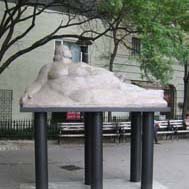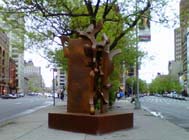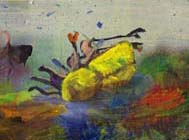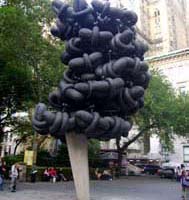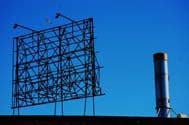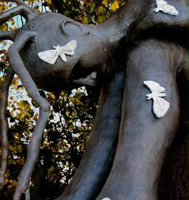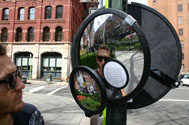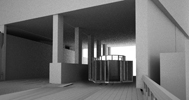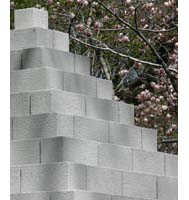Art in the Parks
Through collaborations with a diverse group of arts organizations and artists, Parks brings to the public both experimental and traditional art in many park locations. Please browse our list of current exhibits and our archives of past exhibits below. You can also see past grant opportunities or read more about the Art in the Parks Program.
Public Art Map and Guide
Find out which current exhibits are on display near you, and browse our permanent monument collection.
Search Current and Past Exhibits
2011
Manhattan
Gaston Lachaise, La Montagne (The Mountain)
September 23, 2011 to June 4, 2012
Tramway Plaza, Manhattan
Map/Directions (in Google Maps)
Please note: This is a past exhibit that is no longer installed in the park.
La Montagne (The Mountain) was modeled in 1934 by American Modernist sculptor Gaston Lachaise (1882-1935). The sculpture is the culmination of a series begun in 1913 by Lachaise in New York, where he lived and worked from 1912 until his death in 1935. The work represents at once a landscape and the figure of Isabel Dutaud Nagle, the artist’s muse, model and eventual wife. Lachaise envisioned a piece that was “great and solemn.” He later admitted, “You may say the model is my wife. It is a large, generous figure of great placidity, great tranquility.” Some recognize in Lachaise a revival of the feminine ideal that had flourished for centuries in the voluptuous stone carvings on Hindu temples. Lachaise’s wife inspired virtually all of Lachaise’s sculptures of the female form. “You are the Goddess I seek to express in all my work,” he wrote to her in 1915-16.
This exhibition was made possible by The Lachaise Foundation and The Frelinghuysen-Morris Foundation.
![]()
Miquel Barceló, Elefandret Sculpture at Union Square, New York City
September 13, 2011 to May 29, 2012
Union Square Park Triangle
Union Square Park, Manhattan
Map/Directions (in Google Maps)
Please note: This is a past exhibit that is no longer installed in the park.
Barcelo’s immense Gran Elefandret, balances upright on its trunk, its four massive legs outspread searching for equilibrium. At twenty-six feet tall the sculpture brilliantly portrays an extraordinary, if not impossible physical and cultural feat; this contemporary monument believably captures with humor, scale and Spanish courage the essence of what a public monument can be today.
To further communicate the gravity-defying feat beyond the surprisingly slim trunk and large body, Barceló imparts the mass and weight of the creature through the downward sag of the heavily wrinkled skin, the off-kilter positioning of the huge legs, and the complete overturning of the floppy ears. The highly textured surface of the elephant recalls the artist’s tactile paintings, in which he creates rich topographic, sculpted surfaces on canvas.
Barceló, born in Mallorca in 1957, has spent considerable time in West Africa, and his paintings and sculptures often are often concerned with the natural life cycle.
This is a project by Marlborough Gallery, in cooperation with the Union Square Partnership.
![]()
Bill Barrett, 911 (from the Lexeme Series)
May 4, 2011 to April 28, 2012
Finn Square, Manhattan, Manhattan
Map/Directions (in Google Maps)
Please note: This is a past exhibit that is no longer installed in the park.
Meant to commemorate the 10th anniversary of 9/11, the Lexeme Series began as a way for Barrett to process and talk about the heartbreaking events of September 11, 2001. It includes works in fabricated bronze, stainless steel, and an 11-foot-high Carrara marble piece that was carved in Carrara, Italy, and shown in Zell, Germany. In their own unique way, all of the Lexeme sculptures incorporate the presence of the World Trade Center. With this particular sculpture, Barrett aims to present the idea that life, and positive and creative energy continue to prevail.
Bill Barrett has been a member of the Tribeca community for over 40 years. His studio is just blocks from the installation site. He has exhibited widely throughout the country.
![]()
Jacco Olivier, Untitled
December 15, 2011 to March 12, 2012
Madison Square Park, Manhattan
Map/Directions (in Google Maps)
Please note: This is a past exhibit that is no longer installed in the park.
Six painterly animations by acclaimed Dutch artist Jacco Olivier is the final presentation of Mad.Sq.Art’s 2011 season. Mad. Sq. Art celebrates the artist’s first public art commission in New York City, which features both new, site-specific and existing works displayed throughout the Park. Olivier’s series of stop-motion animations brightens New York’s winter landscape with moving images exemplary of the artist’s characteristically rich color palette and lavishly textured style. The exhibition is on view daily in Madison Square Park from December 15, 2011 through March 12, 2012.
Beginning with a single image, Olivier introduces subtle alterations with each additional layer through his process of over-painting. After he paints and re-paints his images, Olivier photographs each stage of the process as stop-motion animation until an original no longer exists. The resulting work reveals a history of the painting process that captures scraps of narrative and visual iconography brought to light as a moving painting.
According to the artist, Jacco Olivier, exhibiting in Madison Square Park provides “an opportunity to go totally abstract and see things on a molecular level, to change perspective[…] to show an animation in the ground, you really have to look down to see it, which creates a little private moment for the viewer that is free of narrative, subject or meaning.”
This is a project of Mad.Sq.Art.
![]()
Michael Sailstorfer, Tornado
September 20, 2011 to February 19, 2012
Doris Freedman Plaza
Central Park, Manhattan
Map/Directions (in Google Maps)
Please note: This is a past exhibit that is no longer installed in the park.
This arresting sculpture is the first public commission in the United States by Berlin-based artist Michael Sailstorfer. It is a powerful response to the attributes of the site, for which it was conceived, and to the epic scale of New York City.
Rising more than 30 feet to meet the treetops of Central Park, Tornado brings together a series of opposite terms. It combines lightness and weight, with looming black “clouds” made from inflated truck tire inner tubes that gently shift in the breeze. Its muscular steel armature zigzags from top to bottom while the ballooning rubber forms that hang in bunches from its spiraling arms are knotted together in bulging clusters. Like a tornado, which is violently powerful but also literally made of air, Sailstorfer’s towering work provides a visceral experience of sculptural form and materials in tension, massive but also vulnerable.
Tornado is the largest in a series of the artist’s sculptures that draw on rubber tires, inner tubes, and ideas of movement and velocity. Much of his work engages with natural forces and the way we perceive them through form and physical space. At the same time, there is often a hint of whimsy in Sailstorfer’s art, conjuring a sense of playfulness, backyard experimentation, and visual wit.
This is a project by the Public Art Fund.
![]()
Kim Beck, Space Available
March 4, 2011 to January, 2012
On rooftops along Washington Street, between West 13th and Gansevoort Streets
The High Line, Manhattan
Map/Directions (in Google Maps)
Please note: This is a past exhibit that is no longer installed in the park.
Kim Beck presents three sculptures resembling the skeletal framework behind advertising billboards. These blank forms emulate the abounding indicators of the economic recession, such as empty storefronts and "For Sale" signs. Beck's sculptures have the illusion of depth when viewed from the front, but as visitors move past them, the side views reveal that they are completely flat, cut from perspective drawings and built like theater props.
A series of three sculptures are installed on roofs of buildings close to the High Line. They integrate seamlessly into the environment of the High Line neighborhood, echoing existing billboards and buildings in partial states of construction. The existence of the three reinforces their visibility and invites visitors to rethink the logic of what they are seeing.
This is a project by the Friends of the High Line.
![]()
Alison Saar, Feallan and Fallow
September 22, 2011 to December 31, 2011
Madison Square Park, Manhattan
Map/Directions (in Google Maps)
Please note: This is a past exhibit that is no longer installed in the park.
Feallen and Fallow, an exhibition of six larger-than-life figurative sculptures by Los Angeles-based artist Alison Saar, features four newly commissioned bronze works depicting the female form in various stages of maturations through the dual narrative lenses of seasonal cycles and the Greek myth Persephone. The series will premiere alongside the first outdoor presentation in New York City of her iconic 1994 Treesouls figures.
Feallen and Fallow is a commission of the award-winning Mad. Sq. Art program.
![]()
Mary Miss, BROADWAY: 1000 STEPS
September 17, 2011 to December 10, 2011
Montefiore Square, Manhattan
Map/Directions (in Google Maps)
Please note: This is a past exhibit that is no longer installed in the park.
City as Living Laboratory (CaLL) announces the first phase of artist Mary Miss’ BROADWAY: 1000 STEPS at 137th Street and Broadway. The Mary Miss project includes an array of 54 green vertical poles that support convex mirrors with text, images, and guide-by-cell phone numbers. The poles, arranged in clusters, address broad environmental subjects including land, air, water, waste, life, energy, food and health. The mirrors reflect passers-by and highlight elements of the streetscape, such as storm sewers, water towers, and green roofs. Attached to each mirror is a smaller disc with information about related systems--infrastructure on which our urban lifestyle depends. Mary Miss considers these elements visual cues for a BROADWAY: 1000 STEPS “tool kit” that she is developing to address environmental sustainability and the vision of Broadway as a “green corridor” of New York City.
This and future phases will serve as a platform for collaboration between Mary Miss/CaLL, research scientists, municipal policy makers, students, and local community groups. These installations, though individually small in scale, are being developed to reveal the vast network of systems vital to a sustainable city. They are being designed to make sustainability tangible to citizens at street level and catalyze future projects by artists and environmental designers.
In addition to Parks, this project was realized with the support of the New York City Department of Transportation’s (DOT) Urban Art Program.
![]()
Sue De Beer, Haunt Room
October 28, 2011 to December 4, 2011
14th Street Passage
The High Line, Manhattan
Map/Directions (in Google Maps)
Please note: This is a past exhibit that is no longer installed in the park.
Opening a few days before Halloween, De Beer’s Haunt Room is an interactive structure designed to induce haunted feelings in the viewer using infrasound, an audio tone below the threshold of human hearing. Audio tones at very low frequencies are inaudible to humans, yet they are cited as the cause of strange sensations people feel in spaces thought to be haunted—a sense of presence, a dizzy feeling, an inexplicable smell. This theory was tested by designer Usman Haque and the psychology department at Goldsmiths College during a series of experiments, which helped inspire De Beer’s work for the High Line.
Building on the basic concept of the Goldsmiths experiment, De Beer has created a 15 x 15 x 9 foot structure constructed from smoke-colored Plexiglas panels that visually evoke the Seagram Building in Manhattan. As park visitors enter the structure, they encounter a 14-sided featureless chamber inspired by The Beatles’ Abbey Road recording studio and the test site for the Goldsmiths experiments. The space between the interior and exterior walls will be filled with lights emanating a soft glow, and speaker cabinets emitting low-frequency audio tones outside the range of human hearing.
“In my last several years of work I have become interested in the psychological/optical response of the human body to physiological 'prompts' – things like Brion Gysin’s ‘Dream Machine,’ or the way hypnosis can produce visions. I also find it fascinating the way that specific architecture can prompt memory, or nostalgia, remind one of lost time or time passing.”
This is a project by the Friends of the High Line.
![]()
Sol LeWitt, Sol LeWitt:Structures, 1965-2006
May 24, 2011 to December 2, 2011
City Hall Park, Manhattan
Map/Directions (in Google Maps)
Please note: This is a past exhibit that is no longer installed in the park.
Sol LeWitt:Structures, 1965-2006, the first outdoor career survey of Sol LeWitt’s sculptures—or “structures” as he called his three-dimensional works. The landmark exhibition will include 27 works from this seminal artist’s modular, serial, geometric, and irregular structures series that attest to his lifelong engagement with the medium and present his most important ideas about sculpture.
Just a few years after his death in 2007, Sol LeWitt remains one of our most significant and radical artists. He first found his artistic voice in his structures of the mid 1960s, giving rise to a career that would change the way we think about art. Spanning more than 40 years, this exhibition traces that evolution, revealing his remarkable and sustained artistic development.
This is a project by the Public Art Fund.
![]()
